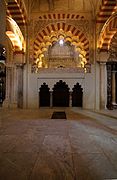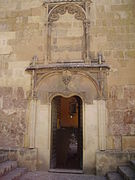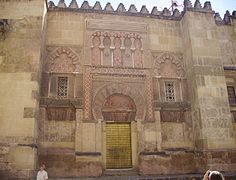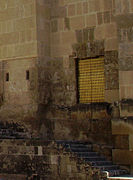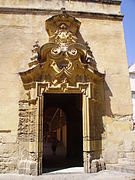Mosque–Cathedral of Córdoba
| Mosque–Cathedral of Córdoba | |
|---|---|
| Cathedral of Our Lady of the Assumption | |
| Great Mosque of Córdoba | |
Mezquita-Catedral de Córdoba (Spanish) | |
 | |
 Mosque–Cathedral of Córdoba Location of Córdoba | |
| 37°52′45.1″N 04°46′47″W / 37.879194°N 4.77972°WCoordinates: 37°52′45.1″N 04°46′47″W / 37.879194°N 4.77972°W | |
| Location | Córdoba, Andalusia |
| Country | Spain |
| Denomination | Catholic |
| Previous denomination | Islam |
| Website | mezquita-catedraldecordoba |
| History | |
| Status | Cathedral |
| Dedication | Assumption of the Virgin Mary |
| Architecture | |
| Functional status | Active |
| Architectural type | Church, Mosque |
| Style | Moorish, Renaissance |
| Groundbreaking | 785 (as a mosque) |
| Completed | 16th century (last major addition as cathedral) |
| Administration | |
| Diocese | Diocese of Córdoba |
UNESCO World Heritage Site | |
| Official name | Historic Centre of Cordoba |
| Criteria | Cultural: i, ii, iii, iv |
| Reference | 313 |
| Inscription | 1984 (8th Session) |
The Mosque–Cathedral of Córdoba[1][2] (Spanish: Mezquita-Catedral de Córdoba), officially known by its ecclesiastical name, the Cathedral of Our Lady of the Assumption (Spanish: Catedral de Nuestra Señora de la Asunción[3]), is the cathedral of the Roman Catholic Diocese of Córdoba dedicated to the Assumption of Mary and located in the Spanish region of Andalusia.[4] Due to its status as a former Islamic mosque, it is also known as the Great Mosque of Córdoba (Spanish: Mezquita de Córdoba),[5][2][6] or the Mezquita.[7][8]
According to traditional accounts a Visigothic church, the Catholic Christian Basilica of Saint Vincent of Saragossa, originally stood on the site of the current Mosque-Cathedral, although the historicity of this narrative has been questioned by scholars.[9][10][11] The Great Mosque was constructed on the orders of Abd ar-Rahman I in 785 CE, when Córdoba was the capital of the Muslim-controlled region of Al-Andalus.[12][13][14][15] It was expanded multiple times afterwards under Abd ar-Rahman's successors up to the late 10th century. Among the most notable additions, Abd ar-Rahman III added a minaret (finished in 958) and his son Al-Hakam II added a richly-decorated new mihrab and maqsura section (finished in 971).[16][13] The mosque was converted to a cathedral in 1236 when Córdoba was captured by the Christian forces of Castile during the Reconquista. The structure itself underwent only minor modifications until a major building project in the 16th century inserted a new Renaissance cathedral nave and transept into the center of the building. The former minaret, which had been converted to a bell tower, was also significantly remodelled around this time. Starting in the 19th century, modern restorations have in turn led to the recovery and study of some of the building's Islamic-era elements.[17][18] Today, the building continues to serve as the city's cathedral and Mass is celebrated therein daily.[19]
The mosque structure is regarded as an important monument in the history of Islamic architecture and is considered by many scholars to have been highly influential on the subsequent "Moorish" architecture of the western Mediterranean regions of the Muslim world.[12][20][21][22][23]:281–284 It is also one of Spain's major historic monuments and tourist attractions,[24] as well as a UNESCO World Heritage Site since 1984.[25]
History[]
Claims of earlier Roman Temple[]
A claim that the site of the mosque-cathedral was once a Roman temple dedicated to Janus dates as far back as Pablo de Céspedes[26][27] and is sometimes still repeated today.[28][29][30][31] However, Robert Knapp, in his overview of Roman-era Córdoba, has dismissed this claim as speculation based on a misunderstanding of Roman milestones found in the area.[32]
Visigothic church[]

According to traditional accounts, the present-day site of the Cathedral–Mosque of Córdoba was originally a Christian church dedicated to Saint Vincent of Saragossa,[33] which was divided and shared by Christians and Muslims after the Umayyad conquest of Hispania.[34][35][19][9][11] As the Muslim community grew and this existing space became too small for prayer, the basilica was expanded little by little through piecemeal additions to the building.[12]:136 This sharing arrangement of the site lasted until 785, when the Christian half was purchased by Abd al-Rahman I, who then proceeded to demolish[10][12] the church structure and build the grand mosque of Córdoba on its site.[35][36] In return, Abd al-Rahman also allowed the Christians to rebuild other ruined churches – including churches dedicated to the Christian martyrs Saints Faustus, Januarius, and Marcellus whom they deeply revered[37] – as agreed upon in the sale terms.[38][39]
The historicity of this narrative has been challenged[10] as archaeological evidence is scant and the narrative is not corroborated by contemporary accounts of the events following Abd al-Rahman I's initial arrival in al-Andalus.[11] The narrative of the church being transformed into a mosque, which goes back to the tenth-century historian Al-Razi, echoed similar narratives of the Islamic conquest of Syria, in particular the story of building the Umayyad Mosque in Damascus.[34][11] For medieval Muslim historians, these parallels served to highlight a dynastic Umayyad conquest of Spain and appropriation of Visigothic Córdoba.[34][11] Another tenth-century source mentions a church that stood at the site of the mosque without giving further details.[11] An archaeological exhibit in the mosque–cathedral of Cordoba today displays fragments of a Late Roman[40] or Visigothic building, emphasizing an originally Christian nature of the complex.[41][42] According to Susana Calvo Capilla, a specialist on the history of the mosque–cathedral, although remains of multiple church-like buildings have been located on the territory of the mosque–cathedral complex, no clear archaeological evidence has been found of where either the church of St. Vincent or the first mosque were located on the site, and the latter may have been a newly constructed building. The evidence suggests that it may have been the grounds of an episcopal complex rather than a particular church which were initially divided between Muslims and Christians.[42][43] Pedro Marfil, an archeologist at the University of Cordoba, has argued for the existence of such a complex – including a Christian basilica – on this site by interpreting the existing archeological remains.[44][45][46] However, this theory has in turn been opposed by Fernando Arce-Sainz, another archeologist, who states that none of the numerous archeological investigations in modern times have turned up remains of Christian iconography, a cemetery, or other evidence that would support the existence of a church.[47][48] Art historian Rose Walker, in an overview of late antique and early medieval art in Spain, has likewise criticized Marfil's view as relying on personal interpretation.[40] The “stratigraphy” of the site is complicated and made more so by its impact on contemporary political debates about cultural identity in Spain.[41] Regardless of what structures may have existed on the site, however, it is almost certain that the building which housed the city's first mosque was destroyed to build Abd ar-Rahman I's Great Mosque and that it had little relation to the latter's form.[10][12]:136[49]
Construction of the mosque[]

The Great Mosque was built in the context of the new Umayyad Emirate in Al-Andalus which Abd ar-Rahman I founded in 756. Abd ar-Rahman was a fugitive and one of the last remaining members of the Umayyad royal family which had previously ruled the first hereditary caliphate based in Damascus, Syria. This Umayyad Caliphate was overthrown during the Abbasid Revolution in 750 and the ruling family were nearly all killed or executed in the process. Abd ar-Rahman survived by fleeing to North Africa and, after securing political and military support, took control of the Muslim administration in the Iberian Peninsula from its governor, Yusuf ibn Abd al-Rahman al-Fihri. Cordoba was already the capital of the Muslim province and Abd ar-Rahman continued to use it as the capital of his independent emirate.[50][16]
Construction of the mosque began in 785 (169 AH) and finished in 786 (170 AH).[12]:136[13]:40[14]:12[15] This relatively short period of construction may have been aided by the reuse of existing Roman and Visigothic materials in the area, especially columns and capitals.[13] Syrian (Umayyad), Visigothic, and Roman influences have been noted in the building's design, but the architect is not known. The craftsmen working on the project probably included local Iberians as well as people of Syrian origin. According to tradition and historical written sources, Abd ar-Rahman involved himself personally and heavily in the project, but the extent of his personal influence in the mosque's design is debated.[13]:44[16]:20[37]
The courtyard of the mosque was planted with trees from at least as early as 808, according to the jurist Ibn Sahl, who himself cited five previous authorities. Although the species of tree is not known, the fact that these were fruit trees is attested in Ibn Sahl, who was consulted as to whether such a garden was forbidden and, if not forbidden, whether it was permitted to eat from it.[51] That the trees remained in the courtyard is demonstrated by two seals of the City of Cordoba, one in 1262 and the other in 1445, both of which show the mosque (which by then had been converted to a cathedral) within whose walls appear tall palm trees.[52] With secure evidence of its early date, this courtyard is the oldest continuously planted Islamic garden in the world.[51]

The original mosque had a roughly square floor plan measuring 74 or 79 square meters per side,[13]:40[16] equally divided between a hypostyle prayer hall to the south and an open courtyard (sahn) to the north. As the mosque was built on a sloping site, a large amount of fill would have been necessary to create a level ground on which to build. The original mosque's most famous architectural innovation, which was preserved and repeated in all subsequent Muslim-era expansions, was its rows of double-tiered arches.[12][13][14][16] Much speculation has been offered on the inspiration for this particular design, including the alleged similarity of the arches to a forest of palm trees from Abd ar-Rahman's youth in Syria; however, a more technical motivation may have been the fact that the available columns being reused from previous buildings were not tall enough on their own to raise the ceiling to the desired height.[14][13][16] The precedent of multi-tiered arches was also already present in the Iberian Peninsula thanks to remaining Roman aqueducts (e.g. the Milagros Aqueduct at Mérida).[14][13]
The mosque's original mihrab (niche in the far wall symbolizing the direction of prayer) no longer exists today but its probable remains were found during archeological excavations between 1932 and 1936. The remains showed that the mihrab's upper part was covered with a shell-shaped hood similar to the later mihrab.[16]:20 The mosque originally had four entrances: one was in the center of the north wall of the courtyard (aligned with the mihrab to the south), two more were in the west and east walls of the courtyard, and a fourth one was in the middle of the west wall of the prayer hall. The latter was known as Bab al-Wuzara' (the "Viziers' Gate", today known as Puerta de San Esteban) and was most likely the entrance used by the emir and state officials, who worked in the palace directly across the street from here.[13]:40 The outer walls were reinforced with large buttresses, which are still visible on the exterior today.[13]:40
Qibla alignment of the mosque[]
Mosques were normally aligned with the qibla, the direction of prayer, which is theoretically the direction of Mecca. From Cordoba, Mecca is to the east-southeast, but the Great Mosque of Cordoba is instead oriented more towards the south.[53][54] This orientation, which doesn't match that of modern mosques, is due to historical differences in opinion about the appropriate direction of the qibla in far western Islamic lands like al-Andalus and Morocco. In this early period, many Muslims in the region preferred a tradition that existed in the western Islamic world (the Maghreb and al-Andalus) according to which the qibla should be oriented towards the south instead of pointing towards the shortest distance to Mecca.[55]:307 This was based on a saying (hadith) of Muhammad which stated that "What is between the east and west is a qibla", which thus legitimized southern alignments.[56][57] This practice may also have sought to emulate the orientation of the walls of the rectangular Kaaba building inside the Great Mosque of Mecca, based on another tradition which considered the different sides of the Kaaba as being associated with different parts of the Muslim world. In this tradition the northwest face of the Kaaba was associated with al-Andalus and, accordingly, the Great Mosque of Cordoba was oriented towards the southeast as if facing the Kaaba's northwestern façade, with its main axis parallel to the main axis of the Kaaba structure (which was oriented from southeast to northwest).[54][53] Although later mosques in Al-Andalus did have more eastern-facing orientations (e.g. the Mosque of Madinat al-Zahra in the 10th century), later expansions of the Great Mosque did not attempt to modify its original alignment.[56]:128–129
Expansions of the mosque[]

In 793 Abd ar-Rahman I's son and successor, Hisham I, added to the mosque a ṣawma'a, a shelter for the muezzin on top of the outer wall, as the mosque did not yet have a minaret (a feature which was not yet standard in early mosques).[16]:21[13] The mosque was significantly expanded by Abd ar-Rahman II in 836[14]:15 (the years 833 and 848 are also cited[16]:21), who preserved and repeated the original design while extending the prayer hall eight bays to the south (i.e. the length of eight arches).[14][13][16] This made the prayer hall 64 metres long from front to back.[13]:45 The work may have still been incomplete when he died in 852 and it appears to have been finished instead by his son and successor, Muhammad I (ruled 852–886).[14][16] Muhammad carried out other general work and restoration on the mosque and is reported to have created a maqsura (a prayer space reserved for the ruler).[14] In 855 he also restored the Bab al-Wuzara' gate (today's Puerta de San Esteban). The decoration of this gate, which thus likely dates from this time, is often noted as an important prototype for later Moorish gateways.[12][14][13][16] Muhammad's son, Al-Mundhir (ruled 886-888), in turn added a treasury to the mosque.[14] His son Abdallah (ruled 888-912) built the mosque's first elevated passage, known as a sabat, which connected the mosque directly with the Umayyad palace across the street. This passage allowed the ruler thenceforth to enter the mosque privately, where he would remain unseen behind the screen of the maqsura, thus separating him from the general public during prayer.[14]:16 (New versions of this bridge would later be rebuilt during the mosque's subsequent expansions.[14]:18)

In the 10th century Abd ar-Rahman III declared a new Caliphate in al-Andalus and inaugurated the height of Andalusi power in the region. As part of his various construction projects, he reworked and enlarged the courtyard of the Great Mosque and built its first true minaret (a tower from which the call to prayer was issued) starting in 951–952.[16][13] The minaret was 47 meters high and had a square base measuring 8.5 meters per side.[16]:62 Scholar Jonathan Bloom has suggested that Abd ar-Rahman III's construction of the minaret – along with his sponsoring of other minarets around the same time in Fez, Morocco – was partly intended as a visual symbol of his growing authority as caliph, and may have been aimed at defying the rival Fatimid Caliphate to the east which eschewed such structures.[21]:106–109 Abd ar-Rahman III also reinforced the northern wall of the courtyard by adding another "façade" in front of the old one on the courtyard side.[13]:71 Historical accounts differ on whether the completed courtyard had a surrounding gallery or portico (as seen today and as was common in the courtyards of other mosques).[58] Many modern scholars affirm that the courtyard was provided with an enveloping gallery at this time and that its design involved an alternation between piers and columns (similar to its current appearance).[13]:73[14]:17–18[16]:61 The new works, including the minaret, were completed in 958, as recorded by a surviving inscription on a marble plaque that includes the name of Abd ar-Rahman III as well as the master builder and the supervisor of works.[16]:62[13]:71
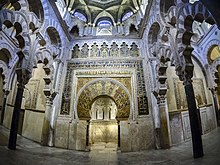
Abd ar Rahman III's son and successor, Al-Hakam II, was a cultured man who was involved in his father's architectural projects. During his own reign, starting in 961, he further expanded the mosque's prayer hall. The hall was extended 45 meters to the south by adding 12 more bays (arches), again repeating the double-tiered arches of the original design.[15]:69 This expansion is responsible for some of the mosque's most significant architectural flourishes and innovations.[13][14][16] At the beginning of al-Hakam's extension, the central "nave" of the mosque was highlighted with an elaborate ribbed dome (now part of the Capilla da Villaviciosa). More famously, a rectangular maqsura area around the mosque's new mihrab was distinguished by a set of unique interlacing multifoil arches. The rectangular area within this, in front of the mihrab, was covered by three more decorative ribbed domes. The domes and the new mihrab niche were finished in 965, and an inscription records the names of four of its craftsmen who also worked at the Reception Hall (Salon Rico) of Madinat al-Zahra.[16][13]:84 Soon after this date both the middle dome of the maqsura and the wall surfaces around the mihrab were covered in rich Byzantine-influenced gold mosaics. According to traditional accounts like that of Ibn 'Idhari, Al-Hakam II had written to the Byzantine emperor (initially Nikephoros II Phokas) in Constantinople requesting that he send him expert mosaicists for the task. The emperor consented and sent him a master craftsman along with about 1600 kg of mosaic tesserae as a gift. The mosaicist trained some of the caliph's own craftsmen, who eventually became skilled enough to do the work on their own. The work was finished by this team in late 970 or early 971.[13][16]
Al-Hakam II's work on the mosque also included the commissioning of a new minbar (pulpit) in 965, which took about 5 to 7 years to finish. Unfortunately, the details of its construction and of its chronology are muddled by sometimes contradictory historical sources. Ibn 'Idhari, for example, implies that Al-Hakam had two minbars built in this period, with one of them possibly having been destroyed or replaced.[59]:50 Either way, whichever minbar survived and became associated with the mosque was celebrated by many writers for its craftsmanship. It was made out of precious woods like ebony, boxwood, and "scented" woods, and it was inlaid with ivory and with other coloured woods such as red and yellow sandalwood. Modern scholars believe the minbar had wheels which allowed it to be rolled in and out of its storage chamber.[59]:50[60]

The mosque's last significant expansion under Muslim rule was ordered by Al-Mansur (Almanzor), the autocratic vizier of Caliph Hisham II, in 987–988.[16][14] Rather than extending the mosque further south, which would have been impossible due to the proximity of the riverbank, Al-Mansur had the mosque extended laterally towards the east, extending both the courtyard and the prayer hall by 47.76 meters and adding eight naves to the mosque. Once again, the same design of double-tiered arches was replicated in the new construction. The capitals produced for the hundreds of new columns, however, have a simpler and less detailed design that may reflect the hurry in which they were produced.[16]:78 The new extension covered 8600 square meters and made the mosque the largest in the Muslim world outside of Abbasid Iraq.[16]:78 The new eastern wall of the mosque featured ten richly-decorated exterior portals similar to the ones on the mosque's western side, although these were heavily restored in the 20th century. Al-Mansur also famously looted the bells of the Cathedral of Santiago de Compostela and reportedly ordered them to be melted down and turned into chandeliers for the mosque, although none of these chandeliers have survived.[16]:79
Later Islamic history of the mosque (11th–12th centuries)[]
After the collapse of the Umayyad Caliphate in Cordoba at the beginning of the 11th century, no further expansions to the mosque were carried out. Indeed, the collapse of authority had immediate negative consequences for the mosque, which was looted and damaged during the fitna (civil conflict) that followed the caliphate's fall (roughly between 1009 and 1030).[61] Cordoba itself also suffered a decline but remained an important cultural center. Under Almoravid rule, the artisan workshops of Cordoba were commissioned to design new richly-crafted minbars for the most important mosques of Morocco – most famously the Minbar of Ali Ibn Yusuf commissioned in 1137 – which were likely inspired by the model of Al-Hakam II's minbar in the Great Mosque.[60]
In 1146 the Christian army of King Alfonso Vll of Léon and Castile briefly occupied Cordoba. The archbishop of Toledo, Don Raimundo, accompanied by the king, led a mass inside the mosque to "consecrate" the building.[17] According to Muslim sources, before leaving the city the Christians plundered the mosque, carrying off its chandeliers, the gold and silver finial of the minaret, and parts of the rich minbar. As a result of both this pillage and the earlier pillage during the fitna, the mosque had lost almost all of its valuable furnishings.[61]
In 1162, after a general period of decline and recurring sieges, the Almohad caliph Abd al-Mu'min ordered that Cordoba be prepared to become his capital in Al-Andalus. As part of this preparation, his two sons and governors, Abu Ya'qub Yusuf and Abu Sa'id, ordered that the city and its monuments be restored. The architect Ahmad ibn Baso (who was later known for his work on the Great Mosque of Seville) was responsible for carrying out this restoration program.[61][55]:315 It is not known exactly which buildings he restored, but it is almost certain that he restored the Great Mosque.[61] It is likely that the mosque's minbar was also restored at this time, since it is known to have survived long afterwards up to the 16th century.[61]
Reconquista and conversion to cathedral (13th–15th centuries)[]

In 1236 Córdoba was conquered by King Ferdinand III of Castile as part of the Reconquista. Upon the city's conquest the mosque was converted into a Catholic cathedral dedicated to the Virgin Mary (Santa Maria).[15][61] The first mass was dedicated here on June 29 of that year.[17] According to Jiménez de Rada, Ferdinand III also carried out the symbolic act of returning the former cathedral bells of Santiago de Compostela that were looted by Al-Mansur (and which had been turned into mosque lamps) back to Santiago de Compostela.[61][62]

Despite the conversion, the early Christian history of the building saw only minor alterations being done to its structure, mostly limited to the creation of small chapels and the addition of new Christian tombs and furnishings.[15][61][14]:24 Even the mosque's minbar was apparently preserved in its original storage chamber, though it is unknown if it was used in any way during this time.[61] (The minbar has since disappeared, but it still existed in the 16th century, when it was apparently seen by Ambrosio de Morales.[61]) The cathedral's first altar was installed in 1236 under the large ribbed dome at the edge of Al-Hakam II's 10th-century extension of the mosque, becoming part of what is today called the Villaviciosa Chapel (Capilla de Villaviciosa) and the cathedral's first main chapel (the Antigua Capilla Mayor).[63] There is no indication that even this space was significantly modified in its structure at this time.[63][61] The area of the mosque's mihrab and maqsura, along the south wall, was converted into the Chapel of San Pedro and was reportedly where the host was stored.[61] What is today the 17th-century Chapel of the Conception (Capilla de Nuestra Señora de la Concepción),[64] located on the west wall near the courtyard, was initially the baptistery in the 13th century.[61] These three areas appear to have been the most important focal points of Christian activity in the early cathedral.[61] The minaret of the mosque was also converted directly into a bell tower for the cathedral, with only cosmetic alterations such as the placement of a cross at its summit.[65][61]
Notably, during the early period of the cathedral-mosque, the workers charged with maintaining the building (which had suffered from disrepair in previous years) were local Muslims (Mudéjars). Some of them were kept on payroll by the church but many of them worked as part of their fulfilment of a "labor tax" on Muslim craftsmen (later extended to Muslims of all professions) which required them to work two days a year on the cathedral building. This tax was imposed by the crown and was unique to the city of Cordoba. It was probably instituted not only to make use of Mudéjar expertise but also to make up for the cathedral chapter's relative poverty, especially vis-à-vis the monumental task of repairing and maintaining such a large building. At the time, Mudéjar craftsmen and carpenters were especially valued across the region and even held monopolies in some Castilian cities such as Burgos.[61]
Other chapels were progressively created around the interior periphery of the building over the following centuries, many of them funerary chapels built through private patronage.[61] The first precisely-dated chapel known to be built along the west wall is the Chapel of San Felipe and Santiago, in 1258.[61] The Chapel of San Clemente was created in the southeast part of the mosque before 1262.[61] A couple of early Christian features, such as an altar dedicated to San Blas (installed in 1252) and an altar of San Miguel (1255), disappeared in later centuries.[61]:121

The first major addition to the building under Christian patrons is the Royal Chapel (Capilla Real), located directly behind the west wall of the Villaviciosa Chapel. It was begun at an uncertain date.[15] While it is sometimes believed to have been started by Alfonso X, Heather Ecker has argued that documentary evidence proves it wasn't begun before the 14th century when Contanza of Portugal, wife of Ferdinand IV, made an endowment for the chapel.[61] It was finished in 1371 by Enrique II, who moved the remains of his father Alfonso XI and grandfather Ferdinand IV here.[15][61][66] (Their remains were later moved in 1736 to the Church of San Hipólito.[66]) The chapel was constructed in a lavish Mudéjar style with a ribbed dome very similar to the neighbouring dome of the Villaviciosa Chapel and with surfaces covered in carved stucco decoration typical of Nasrid architecture at the time.[15] This prominent use of the Moorish-Mudéjar style for a royal funerary chapel (along with other examples like the Mudéjar Alcázar of Seville) is interpreted by modern scholars as a desire by the Christian kings to appropriate the prestige of Moorish architecture in the Iberian Peninsula, just as the Mosque of Cordoba was itself a powerful symbol of the former Umayyad Caliphate's political and cultural power which the Castilians were eager to appropriate.[14][15]
In the late 15th century a more significant modification was carried out to the Villaviciosa Chapel, where a new nave in Gothic style was created by clearing some of the mosque arches on the east side of the chapel and adding Gothic arches and vaulting.[14][15] The nave is dated to 1489 and its construction was overseen by Bishop Íñigo Manrique.[17][63] The nave originally had a series of Byzantine-Italian style frescoes by Alonso Martinez depicting saints and kings, but only one of these frescoes has been preserved to the present day and is being kept at the Museum of Fine Arts in Cordoba.[63]
Major alterations (16th–18th centuries)[]

The most significant alteration of all, however, was the building of a Renaissance cathedral nave and transept – forming a new Capilla Mayor – in the middle of the expansive mosque structure, starting in 1523.[17][15][14] The project, initiated by Bishop Alonso de Manrique,[67] was vigorously opposed by the city council of Cordoba.[15][14] The cathedral chapter eventually won its case by petitioning Charles V, king of Castile and Aragon, who gave his permission for the project to proceed.[14] When Charles V later saw the result of the construction he is reputed to have been displeased, however, and famously commented: "You have destroyed something unique to build something commonplace."[68]
The architect Hernan Ruiz I was put in charge of the design of the new nave and transept. Before his death in 1547[69] he built the choir walls up to the windows and the gothic vaults on the south side.[17] He also worked on the mosque building's eastern section (the extension added by Al-Mansur) by adding gothic vaulting to the mosque naves in this area.[70] His son, Hernan Ruiz II "the Younger", took over the project after his death. He was responsible for building the transept walls to their full height as well as the buttresses upholding the structure.[67] After him, the project was entrusted to architect Juan de Ochoa, who completed the project in a Mannerist style. The final element was the construction of the elliptical central dome of the transept, built between 1599 and 1607.[17][67]

In 1589 a strong storm (or earthquake[71]) caused damage to the former minaret, which was being used as a bell tower, and it was decided to remodel and reinforce the tower.[72] A design by Hernán Ruiz III (son of Hernán Ruiz II) was chosen, encasing the original minaret structure into a new Renaissance-style bell tower.[72][71] Some of the upper sections of the minaret were demolished in the process.[72] Construction began in 1593[17] but eventually stalled due to resources being spent instead on the construction of the new cathedral nave and transept happening at the same time. Hernán Ruiz III died in 1606 and was unable to see its completion. The construction resumed under architect Juan Sequero de Matilla in 1616 and the tower was finished in 1617.[72] The new tower had imperfections, however, and required repairs only a few decades later in the mid-17th century. The cathedral hired architect Gaspar de la Peña to fix the problems. He reinforced the tower and modified the initial design of the Puerta del Perdón ("Door of Forgiveness") which passed through the tower's base. In 1664 Gaspar added a new cupola to the top of the belfry onto which he raised a statue of Saint Raphael made by the sculptors Pedro de la Paz and Bernabé Gómez del Río.[72][71] In 1727 the tower was damaged by another storm and in 1755 pieces of it (mainly decorative details) were damaged by the 1755 Lisbon Earthquake. A French architect, Baltasar Dreveton, was charged with restoring and repairing the structure over a period of 8 years.[72]
In the new Capilla Mayor, after its completion by Juan de Ochoa, Bishop Diego de Mardones initiated the construction of its main altarpiece and provided a significant donation himself for the project. The altarpiece was designed in a Mannerist style by Alonso Matías and construction began in 1618. Other artists who were involved in its execution included Sebastián Vidal, Pedro Freile de Guevara, and Antonio Palomino.[17][73] In March 1748 construction on the choir stalls began, with the commission awarded to Pedro Duque Cornejo. It was initially funded with the help of a large bequest by Archdeacon José Díaz de Recalde in 1742.[17][74] Work on the choir stalls finished in 1757, though Duque Cornejo – who had worked on it continuously for nearly a decade – died just two weeks before the finished choir was officially opened.[75]
Modern restorations (19th–21st centuries)[]

In 1816 the original mihrab of the mosque was uncovered from behind the former altar of the old Chapel of San Pedro. Patricio Furriel was responsible for restoring the mihrab's Islamic mosaics, including the portions which had been lost.[17] Further restoration works concentrating on the former mosque structure were carried out between 1879 and 1923 under the direction of Velázquez Bosco, who among other things dismantled the baroque elements that had been added to the Villaviciosa Chapel and uncovered the earlier structures there.[17] During this period, in 1882, the cathedral and mosque structure was declared a National Monument. Further research work and archaeological excavations were carried out on the mosque structure and in the Courtyard of the Oranges by Félix Hernández between 1931 and 1936.[17] More recent scholars have noted that modern restorations since the 19th century have partly focused on "re-islamicizing" (in architectural terms) parts of the Mosque-Cathedral.[18] This took place in the context of wider conservation efforts in Spain, starting in the 19th century, towards studying and restoring Islamic-era structures.[76][77][16]:272–278
The Mosque-Cathedral was declared a UNESCO World Heritage Site in 1984, and in 1994 this status was extended to the entire historic centre of Cordoba.[78] A restoration project began on the bell tower in 1991 and finished in 2014, while the transept and choir of the Renaissance cathedral were also restored between 2006 and 2009.[17] Further restorations of features like chapels and some of the outer gates have continued to take place up to the late 2010s.[79]
Architecture[]
The Great Mosque of Córdoba held a place of importance amongst the Islamic community of al-Andalus for centuries. In Córdoba, the Umayyad capital, the Mosque was seen as the heart and central focus of the city.[80] Muhammad Iqbal described its interior as having "countless pillars like rows of palm trees in the oases of Syria".[81] To the people of al-Andalus "the beauty of the mosque was so dazzling that it defied any description."[82]
After all of its historical expansions, the mosque-cathedral covers an area of 590 by 425 feet (180 m × 130 m).[2] The building's original floor plan follows the overall form of some of the earliest mosques built from the very beginning of Islam.[80] Some of its features had precedents in the Umayyad Mosque of Damascus, which was an important model built before it.[83][13] It had a rectangular prayer hall with aisles arranged perpendicular to the qibla, the direction towards which Muslims pray.[84] It has thick outer walls with a somewhat fortress-like appearance. To the north is a spacious courtyard (the former sahn), surrounded by an arcaded gallery, with gates on the north, west, and east sides, and fountains that replace the former mosque fountains used for ablutions. A bridge or elevated passage (the sabat) once existed on the west side of the mosque which connected the prayer hall directly with the Caliph's palace across the street.[14][83] Al-Razi, an Arab writer, speaks of the valuable wine-coloured marble, obtained from the mountains of the district, which was much used in embellishing the naves of the mosque.[citation needed]
The Christian-era additions (after 1236) included many small chapels throughout the building and various relatively cosmetic changes. The most substantial and visible additions are the cruciform nave and transept of the Capilla Mayor (the main chapel where Mass is held today) which were begun in the 16th century and inserted into the middle of the former mosque's prayer hall, as well as the remodelling of the former minaret into a Renaissance-style bell tower.[15]
The hypostyle hall[]

The mosque-cathedral's hypostyle hall dates from the original mosque construction and originally served as its main prayer space for Muslims. The main hall of the mosque was used for a variety of purposes. It served as a central prayer hall for personal devotion, for the five daily Muslim prayers and the special Friday prayers accompanied by a sermon. It also would have served as a hall for teaching and for Sharia law cases during the rule of Abd al-Rahman and his successors.[85]
The hall was large and flat, with timber ceilings held up by rows of double-tiered arches (arcades) resting on columns.[80] These rows of arches divided the original building into 11 aisles or "naves" running from north to south, later increased to 19 by Al-Mansur's expansion, while in turn forming perpendicular aisles running east–west between the columns.[86][87][16] The approximately 850 columns were made of jasper, onyx, marble, granite and porphyry.[2] In the original mosque, all of the columns and capitals were reused from earlier Roman and Visigothic buildings, but subsequent expansions (starting with Abd al-Rahman II) saw the incorporation of new Moorish-made capitals that evolved from earlier Roman models.[13]:44–45[14]:14[86] The nave that leads to the mihrab – which was originally the central nave of the mosque until Al-Mansur's lateral expansion of the building altered its symmetry – is slightly wider than the other naves, demonstrating a subtle hierarchy in the mosque's floor plan.[13][16] The double-tiered arches were an innovation that permitted higher ceilings than would otherwise be possible with relatively low columns. They consist of a lower tier of horseshoe arches and an upper tier of semi-circular arches.[16] The voussoirs of the arches alternate between red brick and white stone.[16]:20 Colour alternations like this were common in Umayyad architecture in the Levant and in pre-Islamic architecture on the Iberian Peninsula.[13]:42 According to Anwar G. Chejne, the arches were inspired by those in the Dome of the Rock.[82] Horseshoe arches were known in the Iberian Peninsula in the Visigothic period (e.g. the 7th-century Church of San Juan de Baños), and to a lesser extent in Byzantine and Umayyad regions of the Middle East; however, the traditional "Moorish" arch developed into its own distinctive and slightly more sophisticated version.[13]:43[12]:163–164[14]:13–14
The mosque's architectural system of repeating double-tiered arches, with otherwise little surface decoration, is considered one of its most innovative characteristics and has been the subject of much commentary.[87][14][86][16] The hypostyle hall has been variously described as resembling a "forest of columns"[13]:58 and having an effect similar to a "hall of mirrors".[14]:13 Scholar Jerrilynn Dodds has further summarized the visual effect of the hypostyle hall with the following:[14]:13
Interest in the mosque's interior is created, then, not by the application of a skin of decoration to a separately conceived building but by the transformation of the morphemes of the architecture itself: the arches and voussoirs. Because we share the belief that architectural components must by definition behave logically, their conversion into agents of chaos fuels a basic subversion of our expectations concerning the nature of architecture. The tensions that grow from these subverted expectations create an intellectual dialogue between building and viewer that will characterize the evolving design of the Great Mosque of Cordoba for over two hundred years.
The mosque's original flat wooden ceiling was made of wooden planks and beams with carved and painted decoration.[88][12]:148–149[89] Preserved fragments of the original ceiling – some of which are now on display in the Courtyard of the Oranges – were discovered in the 19th century and have allowed modern restorers to reconstruct the ceilings of some of the western sections of the mosque according to their original style.[12]:149[88] The eastern naves of the hall (in al-Mansur's expansion), by contrast, are now covered by high Gothic vaults which were added in the 16th century by Hernan Ruiz I.[16]:79[70] On the exterior, the building has gabled roofs covered in tiles.
The mihrab and the maqsura of the mosque[]

The prayer hall also has a richly-decorated mihrab (niche symbolizing the direction of prayer) surrounded by an architecturally-defined maqsura (an area reserved for the emir or caliph during prayer), which date from the expansion of Caliph Al-Hakam II after 965. This maqsura area covers three bays along the southern qibla wall in front of the mihrab, and was marked off from the rest of the mosque by an elaborate screen of intersecting horseshoe and polylobed arches; a feature which would go on to be highly influential in the subsequent development of Moorish architecture.[12] The mihrab opens in the wall at the middle of this maqsura, while two doors flank it on either side. The door on the right gave access to a passage which originally led to the sabat, an elevated passage over the street which connected the mosque to the caliph's palace, while the door on the left led to a treasury located behind the qibla wall.[14]:18
The mihrab consists of a horseshoe arch leading to a small heptagonal chamber – the first time that a mihrab consists of an actual room rather than just a niche in the wall[14]:18 – covered by a shell-shaped cupola above a ring of polylobed blind arches and carvings.[16] The mihrab is, in turn, surrounded by a typical arrangement of radiating arch decoration and a rectangular framing or alfiz, which is also seen in the design of the earlier western mosque gate of Bab al-Wuzara (the Puerta de San Esteban today) and was likely also present around the mosque's original mihrab, now vanished.[13]:43 Above this alfiz is another decorative blind arcade of polylobed arches. The lower walls on either side of the mihrab are panelled with marble carved with intricate arabesque vegetal motifs, while the spandrels above the arch are likewise filled with carved arabesques. The voussoirs of the arch, however, as well as the rectangular alfiz frame and the blind arcade above it, are all filled with gold and glass mosaics. Those in the voussoirs and the blind arcade form vegetal and floral motifs, while those in the alfiz and in smaller bands at the springs of the arch contain Arabic inscriptions in Kufic script.[16][14][13] The two doors on either side of the mihrab section are also framed by similar mosaic decoration. The three bays of the maqsura area (the space in front of the mihrab and the spaces in front of the lateral doors) are each covered by ornate ribbed domes. The middle dome, in front of the mihrab, is especially elaborate and is also covered by mosaic decoration, including an inscription around its center which includes verses from the Qur'an (Surah 22: 77–78).[16]:74
Scholars have affirmed that the style of the mosaics in this part of the mosque is heavily influenced by Byzantine mosaics, which corroborates historical accounts of the Caliph requesting expert mosaicists from the Byzantine emperor at the time, who agreed and sent him a master craftsman.[90][16]:73[13]:84 Scholars have argued that this use of Byzantine mosaics is also part of a general desire – whether conscious or not – by the Cordoban Umayyads to evoke connections to the early Umayyad Caliphate in the Middle East, in particular to the Great Umayyad Mosque of Damascus, where Byzantine mosaics were a prominent element of the decoration.[14]:22 The Arabic inscriptions in the mosaics are the first example of a major series of political-religious inscriptions inserted into Umayyad Andalusi architecture. They contain selected excerpts from the Qur'an as well as foundation inscriptions praising the patron (Caliph Al-Hakam II) and the people who assisted in the construction project.[16]:70

The mihrab

Carved marble decoration on the lower walls around the mihrab

The mosaics in the voussoirs of the mihrab arch

Kufic inscriptions in the mosaics of the alfiz above the mihrab

The blind arcade above the alfiz, with mosaics
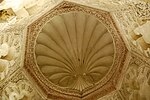
Interior of the mihrab and its shell-shaped dome
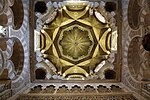
The middle dome over the maqsura, in front of the mihrab
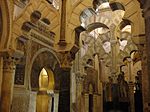
View of the intersecting arches in the maqsura area around the mihrab
Eastern door in the maqsura area (left of the mihrab), which led to the mosque's treasury

Eastern dome of the maqsura (left of the mihrab)
Western door in the maqsura area (right of the mihrab), which led to the passage connecting to the Caliph's palace
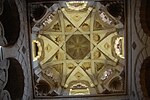
Western dome of the maqsura (right of the mihrab)
Dome of the Villaviciosa Chapel[]
In the nave or aisle of the hypostyle hall which leads to the mihrab, at the spot which marks the beginning of Al-Hakam's 10th-century extension, is a monumental ribbed dome with ornate decoration. The space under this dome was surrounded on three sides by elaborate screens of interlacing arches, similar to those of the maqsura but even more intricate. This architectural ensemble apparently marked the transition from the old mosque to Al-Hakam II's expansion, which some scholars see as having a status similar to a "mosque-within-a-mosque".[13]:75[61]:120 The dome is now part of the Villaviciosa Chapel, while two of the three intersecting arch screens are still present (the western one has disappeared and been replaced by the 15th-century Gothic nave added to the chapel). Like the ornate decorative arches, this dome and the other ribbed domes of the maqsura were highly influential in subsequent Moorish architecture of the period, appearing also in simpler but imaginative forms in the small Bab al-Mardum Mosque in Toledo and giving rise to other ornamental derivations like the much later stucco domes of the Great Mosque of Tlemcen and the Great Mosque of Taza.[12][16]
The interlacing arches at the entrance to Al-Hakam II's 10th-century extension (the Villaviciosa Chapel)
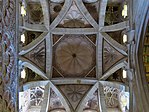
The ribbed dome at the entrance Al-Hakam II's 10th-century extension (the Villaviciosa Chapel)
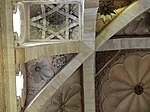
Details of one of the corners of the dome
The courtyard[]

The courtyard is known today as the Patio de los Naranjos or "Courtyard of the Orange Trees".[58][91][92] Until the 11th century, the mosque courtyard (also known as a sahn) was unpaved earth with citrus and palm trees irrigated at first by rainwater cisterns and later by aqueduct. Excavation indicates the trees were planted in a pattern, with surface irrigation channels. The stone channels visible today are not original.[93] As in most mosque courtyards, it had fountains or water basins to help Muslims perform ritual ablutions before prayer. The arches that marked the transition from the courtyard to the interior of the prayer hall were originally open and allowed natural light to penetrate the interior, but most of these arches were walled up during the Christian period (after 1236) as chapels were built along the northern edge of the hall.[58] The courtyard of the original mosque of Abd ar-Rahman I had no surrounding gallery or portico, but it is believed that one was added by Abd ar-Rahman III between 951 and 958.[13]:73[14]:17–18[16]:61 The current gallery, however, was rebuilt with a similar design by architect Hernán Ruiz I under Bishop Martín Fernández de Angulo between 1510 and 1516.[58] The current layout of the gardens and trees is the result of work carried out under Bishop Francisco Reinoso between 1597 and 1601. Today the courtyard is planted with rows of orange trees, cypresses, and palm trees.[58]
Bell tower and former minaret[]


Abd al-Rahman III added the mosque's first minaret (tower used by the muezzin for the call to prayer) in the mid-10th century. The minaret has since disappeared after it was partly demolished and encased in the Renaissance bell tower that is visible today, which was designed by Hernán Ruiz III and built between 1593 and 1617.[72] The minaret's original appearance, however, was reconstructed by modern Spanish scholar Félix Hernández Giménez with the help archeological evidence as well as historical texts and representations.[94] (For example, the two coat-of-arms on the present-day cathedral's Puerta de Santa Catalina depict the tower as it appeared before its later reconstruction.[13]:71)
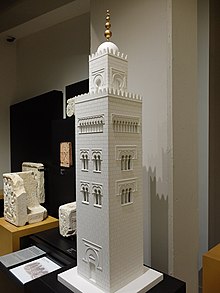
The original minaret was 47 meters high and had a square base measuring 8.5 meters per side.[16]:62 Like other Andalusi and North African minarets after it, it was composed of main shaft and a smaller secondary tower or "lantern" (also with a square base) which surmounted it. The lantern tower was in turn surmounted by a dome and topped by a finial in the shape of a metal rod with two golden spheres and one silver sphere (often referred to as "apples") decreasing in size towards the top. The main tower contained two staircases, which were built for the separate ascent and descent of the tower. About half-way up, the stairways were lit by sets of horseshoe-arch windows whose arches were decorated with voussoirs of alternating colours which were in turn surrounded by a rectangular alfiz frame (similar to the decoration seen around the arches of the mosque's outer gates). On two of the tower's façades there were three of these windows side by side, while on the two other façades the windows were arranged in two pairs. These double pairs or triplets of windows were repeated on the level above. Above these, just below the summit of the main shaft on each façade, was a row of nine smaller windows of equivalent shape and decoration. The top edge of the main shaft was crowned with a balustrade of sawtooth-shaped merlons (similar to those commonly found in Morocco). The lantern tower was decorated by another horseshoe archway on each of its four facades, again featuring an arch of alternating voussoirs framed within an alfiz.[95][16]:62[13]:71, 73
Construction of a new cathedral bell tower to encase the old minaret began in 1593[17] and, after some delays, was finished in 1617.[72] It was designed by architect Hernan Ruiz III (grandson of Hernan Ruiz I), who built the tower up to the bells level but died before its completion. His plans were followed by Juan Sequero de Matilla who finished the tower after him.[72][71] The bell tower is 54 meters tall and is the tallest structure in the city.[71] It consists of a solid square shaft up the level of the bells, where serliana-style openings feature on all four sides. Above this is a lantern structure which in turn is surmounted by a cupola.[72][71] The dome at the summit is topped by a sculpture of Saint Raphael which was added in 1664 by architect Gaspar de la Peña, who had been hired to perform other repairs and fix structural problems. The sculpture was made by Pedro de la Paz and Bernabé Gómez del Río.[72][71] Next to the base of the tower is the Puerta del Perdón ("Door of Forgiveness"), one of the two northern gates of the building.[72]
The Capilla Mayor and cruciform cathedral core[]
The cathedral's main chapel (known from Spanish as the Capilla Mayor) is located at the cruciform nave and transept at the center of the building. This cruciform section was begun in 1523 and finished in 1607.[17][15] The design was drafted by Hernan Ruiz I, the first architect in charge of the project, and was continued after his death by Hernan Ruiz II (his son) and then by Juan de Ochoa. As a result of this long period and the succession of architects, this cruciform section presents an interesting blend of styles.[67] The first two architects introduced Gothic elements into the design which are visible in the elaborate tracery design of the stone vaults over the transept arms and above the altar.[70][67] Juan de Ochoa finished the structure in a more Mannerist style typical at the time, finishing the project with an elliptical dome over the crossing and a barrel vault ceiling – with lunettes along the side – over the choir area.[67][17]
The design and decoration of the ensemble includes extensive iconography. The Gothic-style vault over the main altar is carved with images of musical angels, saints, apostles, and an image of Emperor Charles V (Carlos V), with an image of Mary at the center. The many writings spread amongst the images in turn form a long litany to Mary.[67] The elliptical dome of the crossing rests on four pendentives which are sculpted with images of the four evangelists. On the dome itself, are the images of the eight Fathers of the Church along the outer edge and an image of the Holy Trinity at its center, which together are part of a Counter-Reformist iconographic program.[67] Over the choir area, the central area of the barrel vault ceiling is occupied by images of the Assumption, Saint Acisclus and Saint Victoria, while the sides feature images of David, Solomon, Daniel and Samuel along with the theological virtues.[67]

The nave of the cruciform core of the cathedral or Capilla Mayor, looking towards the altar
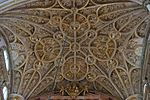
Details of the Gothic lines and iconographic sculpting over the altar of the Capilla Mayor

Elliptical dome over the crossing
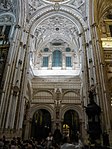
One of the arms of the transept

Gothic decoration on the ceilings of the transept arms

Example of the arches of the former mosque incorporated into the sides of the transept

The choir section and ceiling

Details of the barrel vault ceiling over the choir
Main altar[]
The altar of the Capilla Mayor was begun in 1618 and designed in a Mannerist style by Alonso Matías.[17] After 1627 the works were taken over by Juan de Aranda Salazar, and the altar was finished in 1653.[96] The sculpting was executed by the artists Sebastián Vidal and Pedro Freile de Guevara. The original paintings of the altar were executed by Cristóbal Vela Cobo but they were replaced in 1715 by the current paintings by Antonio Palomino.[73][96] The altar consists of three vertical "aisles" flanked by columns with composite capitals. The central aisle houses the tabernacle (executed by Pedro Freile de Guevara) at its base, while its upper half is occupied by a canvas of the Assumption. The two aisles on the side contain four more canvases depicting four martyrs: Saint Acisclus and Saint Victoria on the bottom halves and Saint Pelagius and Saint Flora in the upper halves. The upper canvases are flanked by sculptures of Saint Peter and Saint Paul, and the central portion is topped by a relief sculpture of God the Father.[96][73]

The main altar

The tabernacle (center) and the lower region of the altar

The upper region of the altar, with the central canvas of the Assumption
Choir stalls[]
The choir stalls, located across from the altar, were crafted from 1748 to 1757 and were executed by Pedro Duque Cornejo.[17][74][75] The ensemble was carved mainly out of mahogany wood and features a row of 30 upper seats and a row of 23 lower seats, all intricately decorated with carvings, including a series of iconographic scenes. At the centre of the ensemble on the west side is a large episcopal throne, commissioned in 1752, that resembles the design of an altarpiece.[74] The lower part of the thrones has three seats, but the most impressive element is the upper part which features a life-size representation of the Ascension of Jesus.[74][75] The last figure which stands above the summit of the ensemble is a sculpture of the Archangel Raphael.[74]
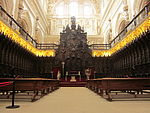
Overall view of the choir

View of the seats on the upper and lower rows

The upper part of the episcopal throne of the choir, featuring a life-size representation of the Ascension
List of chapels[]
West wall, from north to south:
- Capilla de San Ambrosio
- Capilla de San Agustín
- Capilla de Nuestra Señora de las Nieves y San Vicente Mártir
- Capilla de los Santos Simón y Judas de la Mezquita-Catedral de Córdoba
- Capilla de la Concepción de Salizanes o del Santísimo Sacramento
- Capilla de San Antonio Abad
- Capilla de la Trinidad
- Capilla de San Acacio
- Capilla de San Pedro y San Lorenzo
- Museo de San Vicente
South wall, from west to east:
- Capilla de San Bartolomé
- Capilla de Santa Teresa
- Capilla de Santa Inés
- Capilla del Sagrario
East wall, from north to south:
- Capilla de San Antonio de Padua
- Capilla de San Marcos, Santa Ana y San Juan Bautista
- Capilla de San Mateo y Limpia Concepción de Nuestra Señora
- Capilla de San Juan Bautista
- Capilla de Santa Marina, de San Matías y del Baptisterio
- Capilla de San Nicolás de Bari
- Capilla de la Expectación
- Capilla del Espíritu Santo
- Capilla de la Concepción Antigua
- Capilla de San José
- Capilla de la Natividad de Nuestra Señora
- Capilla de Santa María Magdalena
North wall, from west to east:
- Capilla de San Eulogio
- Capilla de San Esteban
- Capilla de Nuestra Señora del Mayor Dolor
- Capilla de la Virgen de la Antigua
- Capilla de San Andrés
- Capilla de la Epifanía
- Capilla de Nuestra Señora del Rosario
- Capilla de las Benditas Ánimas del Purgatorio
- Capilla de los Santos Varones
- Capilla de Santa Francisca Romana y Santa Úrsula
Capilla de Villaviciosa

Capilla Sagrario
Capilla Real
Capilla Teresa
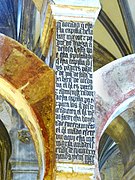
Capilla San Clemente
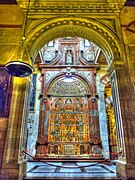
Capilla de la Concepción
Doors[]
Doors of the Islamic period[]

The Puerta de San Esteban (formerly the Bab al-Wuzara in Arabic) is one of the oldest well-preserved and historically significant gateways of Moorish architecture. It was originally the gate by which the Muslim emir and his officials entered the mosque and it presumably existed since the mosque's first construction by Abd ar-Rahman I in the 8th century. However, its decoration was completed by Muhammad I in 855. Centuries of slow deterioration and restoration attempts have erased some elements of its decoration, but major original aspects of it remain. Its historical-architectural significance derives from being the earliest surviving example to display the classic ornamental features of Moorish gateways: a door topped by a horseshoe arch with voussoirs of alternating color, which in turn is framed by a rectangular alfiz.[12]:165–170[14][13]:43[16]:21
Many other gates were added over the course of subsequent expansions of the mosque. These later gates have even more elaborate decoration, particularly from the 10th century during Al-Hakam II's expansion (starting in 961), visible today on the western exterior façade of the former prayer hall. Al-Mansur's final expansion of the mosque a few decades later (starting in 987–988), which extended the mosque laterally to the east, copied the design of the earlier gates of Al-Hakam II's expansion.[14] Al-Mansur's doors are visible on the building's current eastern façade. Some remains of the original eastern doors of Al-Hakam II's expansion, before Al-Mansur's displacement of the eastern wall, are still visible inside the mosque-cathedral today. One example is the Puerta del Punto, located next to the southern wall and serving today as the visitors' exit from the cathedral's treasury rooms.[97] Many of the exterior gates, however, have undergone various periods of decay and restoration. The most elaborate gates on the eastern wall today are in large part the work of 20th-century restorations.[16]:79 Many of the original Arabic inscriptions on these doors have nonetheless been preserved, however. Susana Calvo Capilla has noted that many of the inscriptions on the 10th-century gates have eschatological and proselytizing connotations, possibly reflecting a conscious rebuttal of heterodox religious currents that the authorities deemed threats at the time. Three of the doors, for example, include Qur'anic verses that deny Christian beliefs on the divinity of Christ.[97]
Doors of the Christian period[]
After the mosque's conversion to a cathedral in 1236, Spanish Christian designs were increasingly added to new or existing gates. The small Postigo de la Leche ("Door of the Milk") on the west side of the building has Gothic details dating from 1475.[98] Among the most notable monumental Christian-era portals are the Puerta de las Palmas, the Puerta de Santa Catalina, and the Puerta del Perdón.[99]
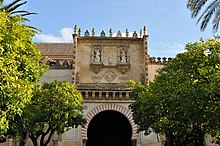
The Puerta de las Palmas (Door of the Palms) is the grand ceremonial gate from the Courtyard of the Oranges to the cathedral's interior, built on what was originally a uniform façade of open arches leading to the former mosque's prayer hall. Originally called the Arco de Bendiciones (Arch of the Blessings), it was the setting for the ceremonial blessing of the royal flag, a ritual which was part of a Spanish monarch's coronation ceremony. Its current form dates from the restoration and remodelling done by Hernán Ruiz I in 1533, who created a plateresque façade above the doorway. The facade's statues depict the Annunciation while, unusually, the smaller figures in the lower corners depict mythological creatures.[99]
The Puerta de Santa Catalina (Door of Saint Catherine) is the main eastern entrance to the Courtyard of the Oranges. Its name referred to the presence of a nearby Convent of Saint Catherine. Its current appearance dates from the work of Hernán Ruiz II, who took over work on the cathedral in 1547 after the passing of his father (Hernán Ruiz I). The gate has a Renaissance façade on its exterior: the doorway is flanked by two columns and is surmounted by a serliana-style composition of columns forming three alcoves topped by a curved lintel. Within the three alcoves are the remains of three murals depicting Saint Catherine (Santa Catalina), Saint Acisclus (San Acisclo) and Saint Victoria (Santa Victoria).[99]
The Puerta del Perdón (Door of Forgiveness) is one of the most ritually important doors of the cathedral, located at the base of the bell tower and directly opposite the Puerta de las Palmas. A gate existed here since the Islamic period; its location is aligned with the mihrab of the mosque and with the central axis of the building before Al-Mansur's expansion.[16]:61 Its first reconstruction in the Christian period of the building dates to 1377, but it has been modified several times since, notably by Sebastián Vidal in 1650.[99] The faded mural paintings inside the blind arches above the outer doorway include a depiction of Our Lady of the Assumption in the middle, with Saint Michel and Saint Raphael on the sides.[99]
List of doors[]
West façade, along Calle Torrijos, north to south:
- Postigo de la leche
- Puerta de los Deanes
- Puerta de San Esteban
- Puerta de San Miguel
- Puerta del Espíritu Santo
- Postigo del Palacio
- Puerta de San Ildefonso
- Puerta del Sabat
Postigo de la Leche.

Puerta de los Deanes.

Puerta de San Esteban.

Puerta de San Miguel.
Puerta del Espíritu Santo.
Postigo del Palacio.

Puerta de San Ildefonso
Puerta del Sabat
East façade, along Calle del Magistrado González Francés, north to south:
- Puerta de la Grada Redonda
- Fuente de Santa Catalina
- Puerta de Santa Catalina
- Puerta de San Juan
- Puerta del Baptisterio
- Puerta de San Nicolás
- Puerta de la Concepción Antigua
- Puerta de San José
- Puerta del Sagrario
- Puerta de Jerusalén
Puerta de la Grada Redonda
Puerta de Santa Catalina

Puerta de San Juan

Puerta del Baptisterio

Puerta de San Nicolás

Puerta de la Concepción Antigua
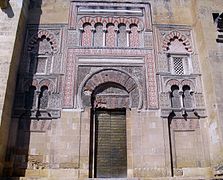
Puerta de San José
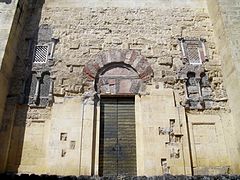
Puerta del Sagrario

Puerta de Jerusalén
North façade, along calle Cardenal Herrero, west to east:
- Puerta del Perdón
- Puerta del Caño Gordo
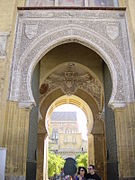
Puerta del Perdón
Puerta del Caño Gordo
2000s Muslim campaigns[]
Muslims across Spain have lobbied the Catholic Church to allow them to pray in the complex, with the Islamic Council of Spain lodging a formal request with the Vatican.[100][101] However, Spanish church authorities and the Vatican have opposed this move.[102] Muslim prayer has not been always banned outright and there are some cases of token concessions in the past, including Saddam Hussein's prayer at the Mihrab in December 1974.[103][104]
These[which?] battles over the cathedral reflect the contested view of what constitutes Spanish history and Spanish identity.[105]
Ownership dispute[]
The building was formally registered for the first time by the Córdoba's Cathedral Cabildo in 2006 on the basis of the article 206 of the Ley Hipotecaria from 1946 (whose constitutionality has been questioned).[106] The diocese never presented a formal title of ownership nor did provide a judicial sentence sanctioning the usurpation on the basis of a long-lasting occupation, with the sole legal argument being that of the building's "consecration" after 1236, as a cross-shaped symbol of ash was reportedly drawn on the floor at the time.[107] Defenders of the ecclesial ownership argue on the basis of continuous and peaceful occupation of the building by the Church whereas defenders of the public ownership argue that the mosque-cathedral never ceased to be a State's property, initially belonging to the Crown of Castile (and henceforth the Spanish State).[108]
PSOE's Isabel Ambrosio, Mayor of Córdoba from 2015 to 2019, defended a model of public and shared management.[109][110] In July 2019, the PP's mayor of Córdoba, José María Bellido, closed down a commission investigating ownership rights, saying it should be reserved for Catholic worship. He noted, "There are no administrative tasks arising from this commission and I've no intention of reactivating it."[111]
Legacy[]

Architectural influence[]
The Great Mosque of Cordoba is frequently cited by modern scholars as a major influence on the subsequent architecture of Al-Andalus and of the western Maghreb (mostly Morocco and Algeria) – in what is known as "Moorish" architecture – due to both its architectural innovations and its symbolic importance as the religious heart of the region's historic Cordoban Caliphate.[12][20][13][21][22][23]:281–284 Amira Bennison, for example, goes on to comment:
Despite the demise of the Umayyad caliphate and the concomitant decline of Córdoba's political status, its great mosque remained one of the most thoroughly described and lauded Islamic buildings for centuries to come. Al-Idrisi, writing in the Almohad era, devoted almost his entire entry on Córdoba, several pages in all, to describing the great mosque, giving almost forensic detail about its constituent parts. The key elements in this respect were its marble columns, its polygonal mihrab chamber, its Qur'an and its minbar, all of which went on to have long histories in the Maghrib, appropriated and adapted by the Almoravids and the Almohads in turn.[23]:284
Georges Marçais (an important 20th-century scholar on this subject[16]:279) also traces the origins of some later architectural features directly to the complex arches of Al-Hakam II's expansion, most notably the complex interlacing arches of the Aljafería in Zaragoza (11th century), the polylobed arches found throughout the region after the 10th century, and the sebka motif which became ubiquitous in Moroccan and Nasrid architecture after the Almohad period (12th-13th centuries).[12]
In popular culture[]
The South Asian Muslim philosopher and poet Muhammad Iqbal, who is widely regarded as having inspired the Pakistan Movement, visited the Great Cathedral of Córdoba in 1931–32. He asked the authorities to offer adhan at the cathedral and was even allowed to offer his prayers there. The deep emotional responses that the mosque evoked in him found expression in his poem called "The Mosque of Cordoba". Allama Iqbal saw it as a cultural landmark of Islam and described it as:[113]
Sacred for lovers of art, you are the glory of faith,
You have made Andalusia pure as a holy land![81]
Louis L'Amour's The Walking Drum features a detailed description of the Court of Oranges in the 12th century.
See also[]
- List of former mosques in Spain
- History of medieval Arabic and Western European domes
- History of early modern period domes
- Timeline of Muslim history
- 12 Treasures of Spain
- List of the oldest mosques
References[]
- ^ "Web Oficial del Conjunto Monumental Mezquita-Catedral de Córdoba". Retrieved 15 August 2016.
- ^ Jump up to: a b c d "Mosque-Cathedral of Córdoba". Encyclopædia Britannica, Inc. Retrieved 15 August 2016.
- ^ 100 Countries, 5,000 Ideas. National Geographic Society. 2011. p. 299. ISBN 9781426207587.
The eight-century Great Mosque with double arches in Córdoba was transformed into the Cathedral of our Lady of Assumption.
- ^ Daniel, Ben (2013). The Search for Truth about Islam. Westminster John Knox Press. p. 93. ISBN 9780664237059.
The church is Catholic and has been for centuries, but when Catholic Spaniards expelled the local Arabic and Muslim population (the people they called the Moors) in 1236, they didn't do what the Catholic Church tended to do everywhere else when it moved in and displaced locally held religious beliefs: they didn't destroy the local religious shrine and build a cathedral of the foundations of the sacred space that had been knocked down. Instead, they built a church inside and up through the roof of the mosque, and then dedicated the entire space to Our Lady of the Assumption and made it the cathedral for the Diocese of Córdoba.
- ^ "Historic Centre of Cordoba". UNESCO. Retrieved 17 August 2016.
The Great Mosque of Cordoba was inscribed on the World Heritage List in 1984
- ^ Lapunzina, Alejandro (2005). Architecture of Spain. Greenwood Publishing Group. p. 81. ISBN 9780313319631.
- ^ Andrew Petersen (11 March 2002). Dictionary of Islamic Architecture. Routledge. p. 55. ISBN 978-1-134-61365-6.
- ^ Lawrence S. Cunningham; John J. Reich; Lois Fichner-Rathus (14 September 2016). Culture and Values: A Survey of the Humanities, Volume I. Cengage Learning. p. 262. ISBN 978-1-337-51494-1.
- ^ Jump up to: a b www.mezquitadecordoba.org, Alhambra Valparaiso Ocio y Cultura S.L. -. "History of the Mosque Cathedral of Cordoba". mezquitadecordoba.org.
- ^ Jump up to: a b c d Jonathan M. Bloom; Sheila S. Blair, eds. (2009). "Cordoba". The Grove Encyclopedia of Islamic Art and Architecture. Oxford University Press.
The tradition that the first mosque in Córdoba was housed in the Christian monastery of St. Vincent, and that it was said to have been shared with the city’s Christian congregation, has been challenged. It is almost certain, however, that the building that housed the early 8th-century mosque was destroyed by ῾Abd al-Rahman I for the first phase of the present Mezquita (Great Mosque).
- ^ Jump up to: a b c d e f Nuha N. N. Khoury (1996). "The Meaning of the Great Mosque of Cordoba in the Tenth Century". Muqarnas. 13: 80–98. doi:10.2307/1523253. JSTOR 1523253.
A myth that associates the mosque's site with the church of Saint Vincent acts as an intermediary step in the transformation of the mosque into a monument of dynastic conquest [...] On the authority of the tenth-century al-Razi, later medieval historians assert that the original founders of the Cordoba mosque shared the church of Saint Vincent with the city's Christian population [...] The account posits a parallel with two earlier Islamic paradigms [...] However, the church of Saint Vincent is neither archaelogically attested as the major edifice mentioned by the historians [...] nor specifically by name in accounts of the events following Abd al-Rahman I's initial arrival in al-Andalus. Rather, the anonymous tenth-century Akhbar Majmu'a on the history of al-Andalus mentions a church, "the site of the present-day Friday mosque"
- ^ Jump up to: a b c d e f g h i j k l m n o p Marçais, Georges (1954). L'architecture musulmane d'Occident. Paris: Arts et métiers graphiques.
- ^ Jump up to: a b c d e f g h i j k l m n o p q r s t u v w x y z aa ab ac ad ae af ag ah ai aj ak Barrucand, Marianne; Bednorz, Achim (1992). Moorish architecture in Andalusia. Taschen. ISBN 3822896322.
- ^ Jump up to: a b c d e f g h i j k l m n o p q r s t u v w x y z aa ab ac ad ae af ag ah ai Dodds, Jerrilynn D. (1992). "The Great Mosque of Córdoba". In Dodds, Jerrilynn D. (ed.). Al-Andalus: The Art of Islamic Spain. New York: The Metropolitan Museum of Art. ISBN 0870996371.
- ^ Jump up to: a b c d e f g h i j k l m n M. Bloom, Jonathan; S. Blair, Sheila, eds. (2009). "Córdoba". The Grove Encyclopedia of Islamic Art and Architecture. Oxford University Press. ISBN 9780195309911.
- ^ Jump up to: a b c d e f g h i j k l m n o p q r s t u v w x y z aa ab ac ad ae af ag ah ai aj ak al am an ao ap aq Bloom, Jonathan M. (2020). Architecture of the Islamic West: North Africa and the Iberian Peninsula, 700-1800. Yale University Press. ISBN 9780300218701.
- ^ Jump up to: a b c d e f g h i j k l m n o p q r s "The history | Web Oficial - Mezquita-Catedral de Córdoba". The history | Web Oficial - Mezquita-Catedral de Córdoba. Retrieved 3 December 2020.
- ^ Jump up to: a b Ecker, Heather (2003). "The Great Mosque of Córdoba in the Twelfth and Thirteenth Centuries". Muqarnas. 20: 113–141. doi:10.1163/22118993-90000041. JSTOR 1523329 – via JSTOR.
Finally, adding to present difficulties in perceiving the sequence of post-conquest restorations, additions, and demolitions is the fact that the cathedral has to a certain extent been “re-islamicized”: twentieth-century restorers have removed medieval sarcophagi and other structures from around the mihrab area and along the qibla wall, erected a sort of maqsura structure around the same area, and replaced the ceiling with one based on that of the Great Mosque of Qayrawan.
- ^ Jump up to: a b Armstrong, Ian (2013). Spain and Portugal. Avalon Travel Publishing. ISBN 9781612370316.
On this site originally stood the Visigoths' Christian Church of San Vicente, but when the Moors came to town in 758 CE they knocked it down and constructed a mosque in its place. When Córdoba fell once again to the Christians, King Ferdinand II and his successors set about Christianizing the structure, most dramatically adding the bright pearly white Renaissance nave where mass is held every morning.
- ^ Jump up to: a b Ewert, Christian (1995). "La mezquita de Córdoba: santuario modelo del Occidente islámico". In Guzmán, López (ed.). La arquitectura islámica del Islam Occidental. Madrid: Lunwerg Editores. pp. 55–68.
- ^ Jump up to: a b c Bloom, Jonathan (1989). Minaret: Symbol of Islam. Oxford University Press. ISBN 9780197280133.
- ^ Jump up to: a b Dodds, Jerrilynn D., ed. (1992). Al-Andalus: The Art of Islamic Spain. New York: The Metropolitan Museum of Art. ISBN 0870996371.
- ^ Jump up to: a b c Bennison, Amira K. (2016). The Almoravid and Almohad Empires. Edinburgh University Press. ISBN 9780748646821.
- ^ "Top things to do in Spain". Lonely Planet. Retrieved 10 December 2020.
- ^ Centre, UNESCO World Heritage. "Historic Centre of Cordoba". UNESCO World Heritage Centre. Retrieved 10 December 2020.
- ^ Ingram, Kevin (2018). Converso Non-Conformism in Early Modern Spain: Bad Blood and Faith from Alonso de Cartagena to Diego Velázquez. Springer. p. 160. ISBN 9783319932361.
- ^ Urquízar-Herrera, Antonio (2017). Admiration and Awe: Morisco Buildings and Identity Negotiations in Early Modern Spanish Historiography. Oxford University Press. p. 160. ISBN 9780192518002.
- ^ "The Great Mosque of Cordoba (article)". Khan Academy. Retrieved 11 December 2020.
- ^ Nayler, Mark. "A Brief History of the Mosque-Cathedral of Córdoba". Culture Trip. Retrieved 11 December 2020.
- ^ Gould, Joan (28 May 1989). "Cordoba's Hymn to Islam (Published 1989)". The New York Times. ISSN 0362-4331. Retrieved 11 December 2020.
- ^ "Mezquita de Córdoba". Archnet. Retrieved 11 December 2020.
- ^ Knapp, Robert C. (1983). Roman Córdoba. University of California Press. p. 62. ISBN 9780520096769.
- ^ "Mezquita de Cordoba - Cordoba, Spain". www.sacred-destinations.com. Retrieved 11 December 2020.
- ^ Jump up to: a b c Ann Christys (2017). "The meaning of topography in Umayyad Cordoba". In Anne E. Lester (ed.). Cities, Texts and Social Networks, 400–1500. Routledge.
It is a commonplace of the history of Córdoba that in their early years in the city, the Muslims shared with the Christians the church of S. Vicente, until ʿAbd al-Raḥmān I bought the Christians out and used the site to build the Great Mosque. It was a pivotal moment in the history of Córdoba, which later historians may have emphasised by drawing a parallel between Córdoba and another Umayyad capital, Damascus. The first reference to the Muslims’ sharing the church was by Ibn Idhārī in the fourteenth century, citing the tenth-century historian al-Rāzī. It could be a version of a similar story referring to the Great Mosque in Damascus, which may itself have been written long after the Mosque was built. It is a story that meant something in the tenth-century context, a clear statement of the Muslim appropriation of Visigothic Córdoba.
- ^ Jump up to: a b Guia, Aitana (1 July 2014). The Muslim Struggle for Civil Rights in Spain, 1985–2010: Promoting Democracy Through Islamic Engagement. Sussex Academic Press. p. 137. ISBN 9781845195816.
It was originally a small temple of Christian Visigoth origin. Under Umayyad reign in Spain (711–1031 CE), it was expanded and made into a mosque, which it would remain for eight centuries. During the Christian reconquest of Al-Andalus, Christians captured the mosque and consecrated it as a Catholic church.
- ^ Jarbel, Rodriguez. Muslim and Christian Contact in the Middle Ages: A Reader. University of Toronto Press. p. 41. ISBN 9781442600669.
- ^ Jump up to: a b Calvert, Albert Frederick; Gallichan, Walter Matthew (1907). Cordova, a City of the Moors (Public domain ed.). J. Lane. pp. 42–.
- ^ Josef W. Meri and Jere L. Bacharach, Medieval Islamic Civilization, Routledge, (2005), p. 176 ff.
- ^ Irving, T. B. (1962). The Falcon of Spain. Ashraf Press, Lahore. p. 82.
- ^ Jump up to: a b Walker, Rose (2016). Art in Spain and Portugal from the Romans to the Early Middle Ages: Routes and Myths. Amsterdam University Press. pp. 125–126.
Pedro Marfil has set out the archaeological arguments for earlier ecclesiastical occupation of the site of the Great Mosque in the sixth century, but these involve a considerable amount of interpretation that he clearly presents as his opinion. The mosaics discovered at basement level may belong to a late Roman complex. The bishops of Córdoba at that period would have had a residence, a cathedral, and other churches, but it remains unclear whether these were on the site of the Mosque, used a converted domus as at Barcelona, or reoccupied part or all of the complex at Cercadilla or other administrative buildings. Fragments of sculpture survive again without any reliable provenance and here without any documentary context. Displayed in the new Museo Arqueológico de Córdoba or in the Cathedral Mosque, pieces of liturgical furniture include altar supports and niche plaques but, unlike the material from Mérida, they do not form a coherent group.
- ^ Jump up to: a b D. Fairchild Ruggles (2010). "The Stratigraphy of Forgetting". In Helaine Silverman (ed.). Contested Cultural Heritage: Religion, Nationalism, Erasure, and Exclusion in a Global World. Springer. pp. 51–67. ISBN 9781441973054.
An archaeological display in the Mosque–Cathedral of Cordoba displays fragments of a Visigothic building, emphasizing an originally Christian nature of the site.
- ^ Jump up to: a b Eric Calderwood (10 April 2015). "The Reconquista of the Mosque of Córdoba". Foreign Policy. Retrieved 29 December 2015.
- ^ Susana Calvo Capilla (2007). "Las primeras mezquitas de al-Andalus a través de las fuentes árabes". Al-Qantara. 28 (1): 169–170. doi:10.3989/alqantara.2007.v28.i1.34.
- ^ Marfil, Pedro (2001). "Córdoba de Teodosio a Abd al-Rahmán III". In Caballero, Luis; Mateos, Pedro (eds.). Visigodos y omeyas: un debate entre la Antigüedad tardía y la Alta Edad Media. Madrid: Consejo Superior de Investigaciones Científicas (CSIC). pp. 117–141.
- ^ Marfil, Pedro (2007). "La basílica de San Vicente en la catedral de Córdoba". Arqueología, Arte e Historia. 14: 33–45.
- ^ Marfil, Pedro (2006). "La sede episcopal de San Vicente en la santa iglesia Catedral de Córdoba". Al-Mulk. 6: 35–58.
- ^ Arce-Sainz, Fernando (2015). "La supuesta basílica de San Vicente en Córdoba: de mito histórico a obstinación historiográfica". Al-Qantara. 36 (1): 11–44. doi:10.3989/alqantara.2015.001.
- ^ Córdoba, Guy Hedgecoe in. "Córdoba's Mosque-Cathedral dispute puts Spanish identity at centre stage". The Irish Times. Retrieved 11 December 2020.
- ^ Bloom, Jonathan M. (2020). Architecture of the Islamic West: North Africa and the Iberian Peninsula, 700-1800. Yale University Press. p. 19. ISBN 9780300218701.
Whatever earlier buildings have stood on the site – visitors today can still see mosaic floors some distance beneath the current floor – their orientation and plans have little to do with the mosque.
- ^ Kennedy, Hugh (1996). Muslim Spain and Portugal: A Political History of al-Andalus. Routledge. ISBN 9781317870418.
- ^ Jump up to: a b Ruggles, D. Fairchild (2008). Islamic gardens and landscapes. Philadelphia: University of Pennsylvania Press. pp. 90–93. ISBN 978-0-8122-0728-6. OCLC 811411235.
- ^ Ruggles, D. F. (2009). "From the Heavens and Hills: The Flow of Water to the Fruited Trees and Ablution Fountains in the Great Mosque of Cordoba". Rivers of Paradise: Water in Islamic Art and Culture. Sheila Blair, Jonathan Bloom, Biennial Hamad bin Khalifa Symposium on Islamic Art and Culture. New Haven: Yale University Press. pp. 90–93. ISBN 978-0-300-15899-1. OCLC 317471939.
- ^ Jump up to: a b Bonine, Michael E. (1990). "The Sacred Direction and City Structure: A Preliminary Analysis of the Islamic Cities of Morocco". Muqarnas. 7: 50–72. doi:10.2307/1523121. JSTOR 1523121.
- ^ Jump up to: a b King, David A. (1995). "The Orientation of Medieval Islamic Religious Architecture and Cities". Journal for the History of Astronomy. 26 (3): 253–274. doi:10.1177/002182869502600305. S2CID 117528323.
- ^ Jump up to: a b Bennison, Amira K. (2016). The Almoravid and Almohad Empires. Edinburgh University Press.
- ^ Jump up to: a b Wilbaux, Quentin (2001). La médina de Marrakech: Formation des espaces urbains d'une ancienne capitale du Maroc. Paris: L'Harmattan. ISBN 2747523888.
- ^ Salmon, Xavier (2018). Maroc Almoravide et Almohade: Architecture et décors au temps des conquérants, 1055-1269. Paris: LienArt.
- ^ Jump up to: a b c d e f "Patio de los Naranjos | Web Oficial - Mezquita-Catedral de Córdoba". Patio de los Naranjos | Web Oficial - Mezquita-Catedral de Córdoba. Retrieved 7 December 2020.
- ^ Jump up to: a b Bloom, Jonathan; Toufiq, Ahmed; Carboni, Stefano; Soultanian, Jack; Wilmering, Antoine M.; Minor, Mark D.; Zawacki, Andrew; Hbibi, El Mostafa (1998). The Minbar from the Kutubiyya Mosque. The Metropolitan Museum of Art, New York; Ediciones El Viso, S.A., Madrid; Ministère des Affaires Culturelles, Royaume du Maroc.
- ^ Jump up to: a b M. Bloom, Jonathan; S. Blair, Sheila, eds. (2009). "Minbar". The Grove Encyclopedia of Islamic Art and Architecture. Oxford University Press. ISBN 9780195309911.
- ^ Jump up to: a b c d e f g h i j k l m n o p q r s t u v w Ecker, Heather (2003). "The Great Mosque of Córdoba in the Twelfth and Thirteenth Centuries". Muqarnas. 20: 113–141. doi:10.1163/22118993-90000041. JSTOR 1523329 – via JSTOR.
- ^ Lowney, Chris (2006). A Vanished World: Muslims, Christians, and Jews in Medieval Spain. Oxford University Press. p. 116. ISBN 9780195311914.
- ^ Jump up to: a b c d "Villaviciosa Chapel | Web Oficial - Mezquita-Catedral de Córdoba". Villaviciosa Chapel | Web Oficial - Mezquita-Catedral de Córdoba. Retrieved 3 December 2020.
- ^ "Capilla de Nuestra Señora de la Concepción". mezquita-catedraldecordoba.es. Retrieved 3 December 2020.
- ^ "Bell Tower | Web Oficial - Mezquita-Catedral de Córdoba". Bell Tower | Web Oficial - Mezquita-Catedral de Córdoba. Retrieved 10 February 2021.
- ^ Jump up to: a b "Royal Chapel | Web Oficial - Mezquita-Catedral de Córdoba". Royal Chapel | Web Oficial - Mezquita-Catedral de Córdoba. Retrieved 4 December 2020.
- ^ Jump up to: a b c d e f g h i "Main Chapel, Transept and Choir | Web Oficial - Mezquita-Catedral de Córdoba". Main Chapel, Transept and Choir | Web Oficial - Mezquita-Catedral de Córdoba. Retrieved 4 December 2020.
- ^ Apple, Raymond Walter (1986). Apple's Europe, an uncommon guide. Atheneum. p. 186.
- ^ "Biografia de Hernán Ruiz". www.biografiasyvidas.com. Retrieved 4 December 2020.
- ^ Jump up to: a b c "Los Hernán Ruiz, saga de arquitectos: Hernán Ruiz I, el Viejo". Arte en Córdoba (in Spanish). Retrieved 4 December 2020.
- ^ Jump up to: a b c d e f g "Bell Tower | Web Oficial - Mezquita-Catedral de Córdoba". Bell Tower | Web Oficial - Mezquita-Catedral de Córdoba. Retrieved 3 December 2020.
- ^ Jump up to: a b c d e f g h i j k l "Belfry Tower of the Mosque-Cathedral of Córdoba". Arte en Córdoba. Retrieved 3 December 2020.
- ^ Jump up to: a b c "Main Altarpiece | Web Oficial - Mezquita-Catedral de Córdoba". Main Altarpiece | Web Oficial - Mezquita-Catedral de Córdoba. Retrieved 4 December 2020.
- ^ Jump up to: a b c d e "Choir stalls | Web Oficial - Mezquita-Catedral de Córdoba". Choir stalls | Web Oficial - Mezquita-Catedral de Córdoba. Retrieved 4 December 2020.
- ^ Jump up to: a b c "Choir stalls of the Mosque-Cathedral Córdoba". Arte en Córdoba. Retrieved 11 December 2020.
- ^ Stubbs, John H.; Makaš, Emily G. (2011). Architectural Conservation in Europe and the Americas. John Wiley & Sons. p. 109. ISBN 9780470901113.
- ^ Fairchild Ruggles, D. (2014). Roxburgh, David J. (ed.). Envisioning Islamic Art and Architecture: Essays in Honor of Renata Holod. Brill. pp. 1–21. ISBN 9789004280281.
- ^ Centre, UNESCO World Heritage. "Historic Centre of Cordoba". UNESCO World Heritage Centre. Retrieved 3 December 2020.
- ^ "Conservation | Web Oficial - Mezquita-Catedral de Córdoba". Conservation | Web Oficial - Mezquita-Catedral de Córdoba. Retrieved 7 December 2020.
- ^ Jump up to: a b c Jayyusi, Salma Khadra, ed. The Legacy of Muslim Spain, 2 Vols.. Leiden: Brill, p.599.
- ^ Jump up to: a b Muhammad Iqbal, The Mosque of Córdoba
- ^ Jump up to: a b Anwar, G. Chejne, Muslim Spain: Its History and Culture, MINNE ed. Minnesota: University Of Minnesota Press, p.364.
- ^ Jump up to: a b The Literature of Al-Andalus (The Cambridge History of Arabic Literature). New Ed ed. New York: Cambridge University Press, 161.
- ^ The Literature of Al-Andalus, p.159
- ^ Jan, Read. The Moors in Spain and Portugal. London: Rowman & Littlefield Pub Inc, p.56.
- ^ Jump up to: a b c Sánchez Llorente, Margarita. "Great Mosque of Córdoba". Discover Islamic Art, Museum With No Frontiers. Retrieved 6 December 2020.
- ^ Jump up to: a b "Qantara - Mosque of Córdoba". www.qantara-med.org. Retrieved 6 December 2020.
- ^ Jump up to: a b "CVC. Mezquita de Córdoba". cvc.cervantes.es. Retrieved 21 February 2021.
- ^ M. Bloom, Jonathan; S. Blair, Sheila, eds. (2009). "Woodwork". The Grove Encyclopedia of Islamic Art and Architecture. Oxford University Press. ISBN 9780195309911.
- ^ Stern, Henri (1976). Les mosaïques de la Grande Mosquée de Cordoue. Berlin: Walter de Gruyter.
- ^ "Courtyard of the Orange trees of Viana Palace, Córdoba". Arte en Córdoba. Retrieved 11 December 2020.
- ^ "Mezquita | Córdoba, Spain Attractions". Lonely Planet. Retrieved 11 December 2020.
- ^ Ruggles, D. Fairchild (2008). Islamic Gardens and Landscapes. University of Pennsylvania Press. p. 152. ISBN 978-0-8122-4025-2.
- ^ Hernández Giménez, Félix (1975). Alminar de Abd-al-Rahman III en la Mezquita Mayor de Córdoba: genesis y repercusiones. Granada: Patronato de la Alhambra. ISBN 84-85133-05-6.
- ^ Hernández Giménez, Félix (1975). El alminar de ʻAbd al-Raḥmān III en la Mezquita Mayor de Cordoba: Genesis y repercusiones. Granada: Patronato de la Alhambra. ISBN 9788485133055.
- ^ Jump up to: a b c "Main Altar of the Mosque-Cathedral of Córdoba". Arte en Córdoba. Retrieved 11 December 2020.
- ^ Jump up to: a b Calvo Capilla, Susana (2018). "The Visual Construction of the Umayyad Caliphate in Al-Andalus through the Great Mosque of Cordoba". Arts. 7 (3).
- ^ Montealegre, L.; Barrios, J.; Nieto, M. (1996). "The materials of construction of the west wall of the Mosque of Cordoba (Spain) and their deterioration". In Rieder, Josef (ed.). 8th International Congress on Deterioration and Conservation of Stone. Berlin: Elsevier B.V. pp. 51–60. ISBN 978-0-444-50517-0.
- ^ Jump up to: a b c d e "Noteworthy doors | Web Oficial - Mezquita-Catedral de Córdoba". Noteworthy doors | Web Oficial - Mezquita-Catedral de Córdoba. Retrieved 16 February 2021.
- ^ Sills, Ben (19 April 2004). "Cathedral may see return of Muslims". The Guardian. London.
- ^ Thomson, Muslims ask Pope to OK worship in ex-mosque, Reuters, (2011), [1]
- ^ Fuchs, Dale (28 December 2006). "Pope asked to let Muslims pray in cathedral". The Guardian. London.
- ^ Planelles, Manuel (28 December 2006). "El obispo de Córdoba rechaza el rezo musulmán en la mezquita". El País.
- ^ "Sadam Husein llevó su rezo a la Mezquita en un viaje oficial". Diario de Córdoba. 2 March 2003.
- ^ D. Fairchild Ruggles, "The Stratigraphy of Forgetting: The Great Cathedral of Cordoba and Its Contested Legacy," in Contested Cultural Heritage, ed. Helaine Silverman. New York: Springer, 2011, pp. 51–67. Spanish translation in the journal Antípoda:Revista de Antropología y Arqueología (Bogotá, Colombia) 12 (2011): 19–38.
- ^ Agudo Zamora 2015, pp. 4; 17–18.
- ^ Agudo Zamora 2015, p. 8.
- ^ Agudo Zamora, Miguel (2015). "La inmatriculación de la Mezquita-Catedral de Córdoba: tutela del patrimonio y relevancia constitucional". Estudios de Deusto. Universidad de Deusto. 63 (2): 15–45. doi:10.18543/ed-63(2)-2015pp15-45. ISSN 0423-4847.
- ^ León, José Manuel (7 November 2018). "Ambrosio pone a la Alhambra de ejemplo de gestión compartida para la Mezquita" [Ambrosio brings up the Alhambra as an example of shared management for the Mezquita] (in Spanish). Cadena SER. Retrieved 24 February 2021.
- ^ "Un comité de expertos considera que la Mezquita de Córdoba nunca ha sido propiedad de la Iglesia" [A committee of experts consider that the Mezquita in Córdoba has never been church property] (in Spanish). RTVE. 15 September 2019. Retrieved 24 February 2021.
- ^ Rose Gamble, "News Briefing: Church in the World" in The Tablet, 1 August 2019, 23
- ^ "Interior of a Mosque at Cordova". The Walters Art Museum.
- ^ "Iqbal and Spain – Home Page". allamaiqbal.com.
Further reading[]
- Jover Báez, J.; Rosa, B. (2017). "Patrimonio cultural en disputa: la Mezquita-Catedral de Córdoba". Cuadernos Geográficos. 56 (1): 322–343.
- Messina, Barbara (2004). Geometrie in pietra. La moschea di Cordova. Naples: Giannini. ISBN 9788874312368.
- D.F. Ruggles, “From the Heavens and Hills: The Flow of Water to the Fruited Trees and Ablution Fountains in the Great Mosque of Cordoba,” in Rivers of Paradise: Water in Islamic Art, ed. S. Blair and J. Bloom (London: Yale University Press, 2009), pp. 81–103
- D.F. Ruggles, Islamic Gardens and Landscapes (University of Pennsylvania Press, 2008)
External links[]
| Wikimedia Commons has media related to Mezquita de Córdoba. |
- Official website
- Mezquita (Great Mosque) of Córdoba at Google Maps
- The Mosque of Cordova (during early 19th century)
- Al-Andalus: the art of Islamic Spain, an exhibition catalogue from The Metropolitan Museum of Art (fully available online as PDF), which contains material on the Mosque–Cathedral of Córdoba (see index)
- The Great Mosque of Cordoba in the tenth century, VirTimePlace.
- General information about the mosque and opening hours
- Moorish architecture in Spain
- Buildings and structures in Córdoba, Spain
- Historic centre of Córdoba, Spain
- Former mosques in Spain
- Roman Catholic churches in Córdoba, Spain
- Conversion of non-Christian religious buildings and structures into churches
- Arcades (architecture)
- 8th-century mosques
- 7th-century churches in Spain
- Bien de Interés Cultural landmarks in the Province of Córdoba (Spain)
- Roman Catholic cathedrals in Andalusia
- Religious buildings and structures converted into mosques
- Buildings converted to Catholic church buildings



































